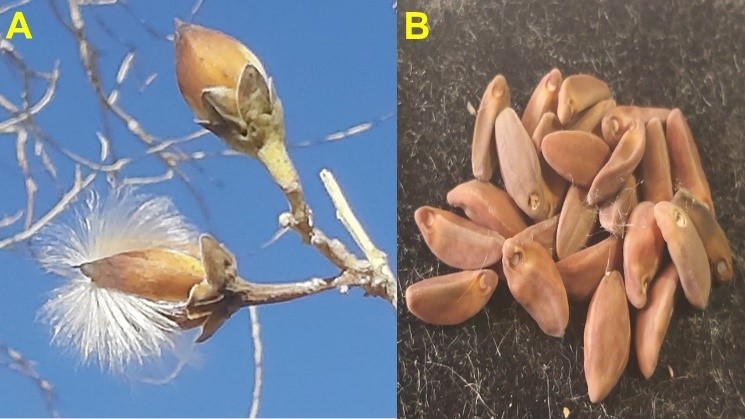Seed viability Ipomoea arborescens (Humb. & Bonpl. ex Willd.) G.Don
Abstract
Ipomoea arborescens is a tree native to the state of Sonora, of social, economic and cultural importance in rural areas. It is palatable to wildlife and domestic animals. Due to successive anthropogenic issues, a defragmentation of natural ecosystems occurs year after year, causing a low rate in forest populations coupled with global warming that interferes with the quality and quality of the seeds. The objective of this work was to evaluate the viability of white stick (Ipomoea arborescens) seeds using 2,3,5-triphenyltetrazolium chloride at two concentrations (0.5 and 1.0%) and two incubation times (24 and 48 h). A randomized design was used using an ANOVA and a Tukey-Kramer comparison of means with P<0.05. According to the results obtained, there were no significant differences according to the concentrations and evaluation times, showing a viability at 24 h for concentrations of 0.5 and 1.0% from 99.33 to 99.67% and when evaluating the seeds at 48 h. using concentrations of 0.5 and 1.0% was 99.33 to 100%. These values indicate that the seeds of Ipomoea arborescens present an accepted percentage of viability, showing less than 1.0% of non-viable seeds. Therefore, Ipomoea arborescens seeds can be used for reforestation as long as they have an adequate pre-germination treatment.
e2023-6
References
AL-TURKI T, Baskin C. 2017. Determination of seed viability of eight wild sandi arabian species by germination and X-ray tests. Saudi Journal of Biological Sciences. 24(4):822-829. https://doi.org/10.1016/j.sjbs.2016.06.009
BARONE J, Duarte E, Luna C. 2016. Determinación de la eficacia de métodos de evaluación de calidad de semillas de especies forestales nativas de la Selva Atlántica. Quebracho-Revista de Ciencias Forestales. 24(1,2):70-80.
http://www.scielo.org.ar/scielo.php?script=sci_arttext&pid=S1851-30262016000200070
CLEMENTE AD, de Carvalho ML, Guimarães RM, Zeviani WN. 2011. Preparo das sementes de Café para avaliação da viabilidade pelo teste de tetrazólio. Revista Brasileira de sementes. 33(1): 38-44. https://doi.org/10.1590/S0101-31222011000100004
COURTIS Azul C. 2013. Guía de Estudio Cátedra de Fisiología Vegetal. FaCENA. Departamento: Biología. Área: Botánica. Pp. 22.
https://exa.unne.edu.ar/biologia/fisiologia.vegetal/GuiadeestudioGerminacion.pdf
DOSTERT Nicolas, Caceres Fatima, Brokamp Grischa, Maximilian Weigend. 2018. Propagación in situ de ratania Krameria lappacea (Krameriaceae): factores limitantes de la propagación natural y efectos de resiembra. Rev. peru. biol. 25(1):029 – 034. ISSN-L 1561-0837. https://doi.org/10.15381/rpb.v25i1.14345
GALLO C, Enrico JM, Cravioto R, Arango M. 2012. Variabilidad de la viabilidad y vigor de lotes de semillas de soja con presencia de simientes verdes pertenecientes a cultivares de distintos grupos de maduración producidos en dos fechas de siembra. Revista de investigaciones agropecuarias. 38(2):133-140.
http://www.scielo.org.ar/scielo.php?script=sci_arttext&pid=S1669-23142012000200006&lng=es&tlng=es.
INEGI (Instituto Nacional de Estadística Geografía e Informática). 2007. Mapa Digital de México. Sección Edafología. https://www.inegi.org.mx/temas/edafologia/
ISTA [International Seed Testing Association]. 2019. International Rules for Seed Testing. Zurich, Switzerland: Seed Science & Technology. ISBN: 3906549275 https://doi.org/10.15258/istarules.2019.F
JMP Statistical Discovery LLC. 2022. Discovering JMP® 17. Cary, NC: JMP Statistical Discovery LLC.
https://www.jmp.com/content/dam/jmp/documents/es/support/jmp17/discovering-jmp-es.pdf
MC CAUGHEY-ESPINOZA DM, Ayala-Astorga GI, Burboa-Zazueta MG, Retes-López R, Ochoa-Meza A. 2018. Uso de plantas nativas para la rehabilitación de canteras en Sonora. Idesia (Arica). 36(4):17-24.
https://dx.doi.org/10.4067/S0718-34292018005002401
MC CAUGHEY-ESPINOZA DM, Buitimea-Cantúa GV, Buitimea-Cantúa NE, Ayala-Astorga GI, Ochoa-Meza A. 2020. Propiedades fisicoquímicas y rendimiento de frutos de chile chiltepín (Capsicum annuum var. glabriusculum Dunal) cultivados bajo diferentes condiciones de crecimiento. Idesia (Arica). 38(3):77-86. https://dx.doi.org/10.4067/S0718-34292020000300077
MC CAUGHEY-ESPINOZA DM. 2022. Micropropagación, establecimiento y desarrollo en campo de Krameria erecta Wild. ex Schult. & Schult f en Sonora, México. Tesis de Doctorado. Universidad Autónoma de Sinaloa. México.
MARRERO P, Padilla DP, Valdés F, Nogales M. 2007. Comparison of three chemical tests to assess seed viability: the seed dispersal system of the Macaronesian endemic plant Rubia fruticose (Rubiaceae) as an example. Chemoecology. 17 (1): 47-50.
http://dx.doi.org/10.1007/s00049-006-0360-x
MEIRA M, Silva EPD, David JM, David J. P. 2012. Review of the genus Ipomoea: traditional uses, chemistry and biological activities. Revista Brasileira de Farmacognosia. 22:682-713. https://doi.org/10.1590/S0102-695X2012005000025
OLIVA-VALLE M, Vacalla-Ochoa F, Pérez-Chuquimez D, Tucto-Chávez A. 2014. Recolección de semillas de especies forestales nativas: experiencia en Molinopampa, Amazonas-Perú. https://hdl.handle.net/20.500.12921/347
PADILLA H. 2018. Es Sonora el estado con mayor deforestación. elimparcial.com. http://www.elimparcial.com/EdicionEnLinea/Notas/Sonora/30062018/1352966
PINTO TL, Filho JM, Forti VA, Carvalho CD, Gomes Junior FG. 2009. Avaliação da viabilidade de sementes de pinhão manso pelos testes de tetrazólio e de raios X. Revista Brasileira de Sementes. 31(2): 195-201. https://doi.org/10.1590/S0101-31222009000200023
RAO NK, Hanson J, Dulloo ME, Ghosh K, Novell D, Larinde M. 2007. Manual para el manejo de semillas en bancos de germoplasma. Roma, Italia: Biodiversity InternationaL. Pp. 182. file:///C:/Users/HP/Downloads/1261.pdf
SAGARPA (Secretaria de Ganadería Agricultura, Rural, Pesca y Alimentación). 2010. Diagnóstico Sectorial Agropecuario, Pesquero y Recursos Naturales del Estado de Sonora. Pp. 52.
SALAZAR SA, Botello EA. 2018. Viabilidad de semillas de Glycine max (L.) utilizando la prueba de tetrazolio. Revista de Investigación Agraria y Ambiental. 9(2): 89-98.
http://doi.org/10.22490/21456453.2270
SOTO González José, Valiengo Valeri Sérgio. 2010. Prueba de la conductividad eléctrica en la evaluación fisiológica de la calidad de semillas en Zeyheria tuberculosa. Bosque (Valdivia). 32. 197-202. http://doi.org/10.4067/S0717-92002011000200010
TERRAZAS T, Aguilar‐Rodríguez S, Ojanguren CT. 2011. Development of successive cambia, cambial activity, and their relationship to physiological traits in Ipomoea arborescens (Convolvulaceae) seedlings. American Journal of Botany. 98(5):765-774. https://doi.org/10.3732/ajb.1000182
VICTORIA JA. 2006. Viabilidad en tetrazolio de semillas de caléndula y eneldo. Acta Agronómica. 55(1): 31-41.
https://revistas.unal.edu.co/index.php/acta_agronomica/article/view/193
TAKAO S, de Souza TB, Custódio CC, Neto NBM. 2017. Refining the tetrazolium test for evaluation of Cattleya labiata and C. tigrina seeds viability. Australian Journal of Crop Science. 11(10): 1320-1326. http://doi.org/10.21475/ajcs.17.11.10.pne606

Downloads
Published
Issue
Section
License

This work is licensed under a Creative Commons Attribution-NonCommercial 4.0 International License.


